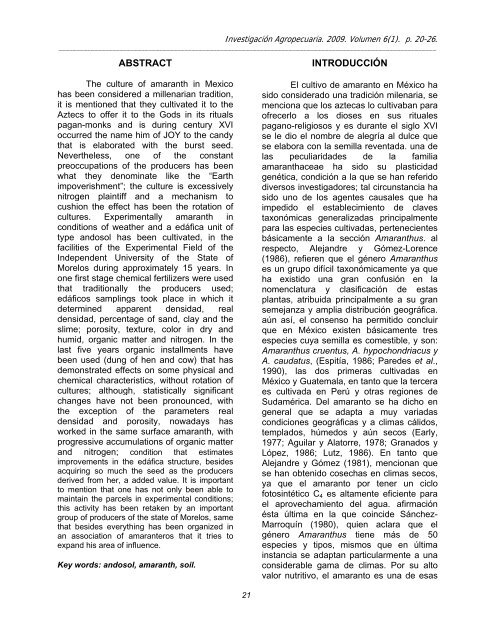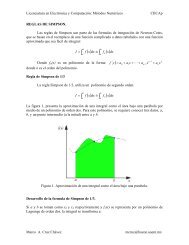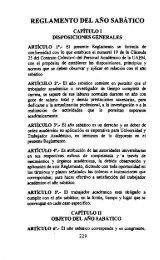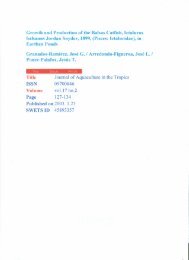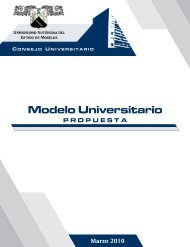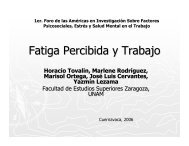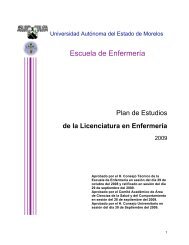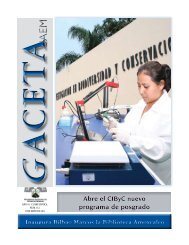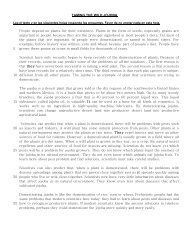Descargar - UAEM - Universidad Autónoma del Estado de Morelos
Descargar - UAEM - Universidad Autónoma del Estado de Morelos
Descargar - UAEM - Universidad Autónoma del Estado de Morelos
Create successful ePaper yourself
Turn your PDF publications into a flip-book with our unique Google optimized e-Paper software.
Investigación Agropecuaria. 2009. Volumen 6(1). p. 20-26.<br />
_________________________________________________________________________________________________________<br />
ABSTRACT<br />
The culture of amaranth in Mexico<br />
has been consi<strong>de</strong>red a millenarian tradition,<br />
it is mentioned that they cultivated it to the<br />
Aztecs to offer it to the Gods in its rituals<br />
pagan-monks and is during century XVI<br />
occurred the name him of JOY to the candy<br />
that is elaborated with the burst seed.<br />
Nevertheless, one of the constant<br />
preoccupations of the producers has been<br />
what they <strong>de</strong>nominate like the “Earth<br />
impoverishment”; the culture is excessively<br />
nitrogen plaintiff and a mechanism to<br />
cushion the effect has been the rotation of<br />
cultures. Experimentally amaranth in<br />
conditions of weather and a edáfica unit of<br />
type andosol has been cultivated, in the<br />
facilities of the Experimental Field of the<br />
In<strong>de</strong>pen<strong>de</strong>nt University of the State of<br />
<strong>Morelos</strong> during approximately 15 years. In<br />
one first stage chemical fertilizers were used<br />
that traditionally the producers used;<br />
edáficos samplings took place in which it<br />
<strong>de</strong>termined apparent <strong>de</strong>nsidad, real<br />
<strong>de</strong>nsidad, percentage of sand, clay and the<br />
slime; porosity, texture, color in dry and<br />
humid, organic matter and nitrogen. In the<br />
last five years organic installments have<br />
been used (dung of hen and cow) that has<br />
<strong>de</strong>monstrated effects on some physical and<br />
chemical characteristics, without rotation of<br />
cultures; although, statistically significant<br />
changes have not been pronounced, with<br />
the exception of the parameters real<br />
<strong>de</strong>nsidad and porosity, nowadays has<br />
worked in the same surface amaranth, with<br />
progressive accumulations of organic matter<br />
and nitrogen; condition that estimates<br />
improvements in the edáfica structure, besi<strong>de</strong>s<br />
acquiring so much the seed as the producers<br />
<strong>de</strong>rived from her, a ad<strong>de</strong>d value. It is important<br />
to mention that one has not only been able to<br />
maintain the parcels in experimental conditions;<br />
this activity has been retaken by an important<br />
group of producers of the state of <strong>Morelos</strong>, same<br />
that besi<strong>de</strong>s everything has been organized in<br />
an association of amaranteros that it tries to<br />
expand his area of influence.<br />
Key words: andosol, amaranth, soil.<br />
21<br />
INTRODUCCIÓN<br />
El cultivo <strong>de</strong> amaranto en México ha<br />
sido consi<strong>de</strong>rado una tradición milenaria, se<br />
menciona que los aztecas lo cultivaban para<br />
ofrecerlo a los dioses en sus rituales<br />
pagano-religiosos y es durante el siglo XVI<br />
se le dio el nombre <strong>de</strong> alegría al dulce que<br />
se elabora con la semilla reventada. una <strong>de</strong><br />
las peculiarida<strong>de</strong>s <strong>de</strong> la familia<br />
amaranthaceae ha sido su plasticidad<br />
genética, condición a la que se han referido<br />
diversos investigadores; tal circunstancia ha<br />
sido uno <strong>de</strong> los agentes causales que ha<br />
impedido el establecimiento <strong>de</strong> claves<br />
taxonómicas generalizadas principalmente<br />
para las especies cultivadas, pertenecientes<br />
básicamente a la sección Amaranthus. al<br />
respecto, Alejandre y Gómez-Lorence<br />
(1986), refieren que el género Amaranthus<br />
es un grupo difícil taxonómicamente ya que<br />
ha existido una gran confusión en la<br />
nomenclatura y clasificación <strong>de</strong> estas<br />
plantas, atribuida principalmente a su gran<br />
semejanza y amplia distribución geográfica.<br />
aún así, el consenso ha permitido concluir<br />
que en México existen básicamente tres<br />
especies cuya semilla es comestible, y son:<br />
Amaranthus cruentus, A. hypochondriacus y<br />
A. caudatus, (Espitía, 1986; Pare<strong>de</strong>s et al.,<br />
1990), las dos primeras cultivadas en<br />
México y Guatemala, en tanto que la tercera<br />
es cultivada en Perú y otras regiones <strong>de</strong><br />
Sudamérica. Del amaranto se ha dicho en<br />
general que se adapta a muy variadas<br />
condiciones geográficas y a climas cálidos,<br />
templados, húmedos y aún secos (Early,<br />
1977; Aguilar y Alatorre, 1978; Granados y<br />
López, 1986; Lutz, 1986). En tanto que<br />
Alejandre y Gómez (1981), mencionan que<br />
se han obtenido cosechas en climas secos,<br />
ya que el amaranto por tener un ciclo<br />
fotosintético C4 es altamente eficiente para<br />
el aprovechamiento <strong><strong>de</strong>l</strong> agua. afirmación<br />
ésta última en la que coinci<strong>de</strong> Sánchez-<br />
Marroquín (1980), quien aclara que el<br />
género Amaranthus tiene más <strong>de</strong> 50<br />
especies y tipos, mismos que en última<br />
instancia se adaptan particularmente a una<br />
consi<strong>de</strong>rable gama <strong>de</strong> climas. Por su alto<br />
valor nutritivo, el amaranto es una <strong>de</strong> esas


